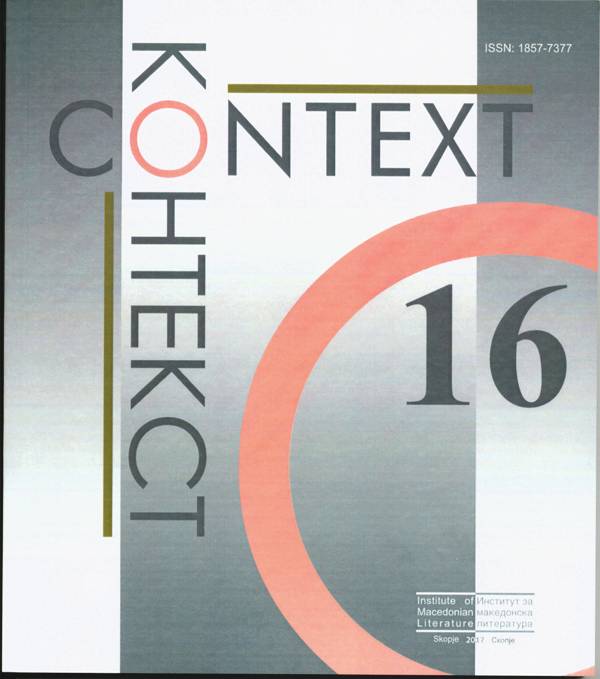Прото-стриповите и библиската венерација во средновековната графичка литература
PROTO-COMICS AND BIBLICAL VENERATION IN MEDIEVAL GRAPHIC LITERATURE
Author(s): Boshko KaradzovSubject(s): Biblical studies, Sociology of Art
Published by: Институт за македонска литература
Keywords: comic books; proto-comic; veneration; medieval graphic literature; medieval manuscript
Summary/Abstract: Every art, especially comic book art as a graphic storytelling, draws its aesthetic legitimacy through the specific and autonomous media identity and through the capacity for social and cultural influence. The first one speaks about the iconography of the comic book language and its authentic bimodal literacy, and the second one about the subversive potential of the comics and its capacity for causing social and cultural changes. However, what gives the final legitimization of every art discipline is always its history and the highest achievements in it. His-tory of comic book art has been incredibly rich and different over the last hundred years. From Rudolf Töpffer and his Les amours de Mr. Vieux Bois (1837), through the golden age of the superhero comic books, to the latest masterpieces of contemporary comic art works such as Habibi (2011) by Craig Thompson. In it, it is widely recognized that the comic book art, formally speaking, is a graphic storytelling in which the fable and iconic elements are laced in a forme of narrative sequential side-by-side visual compositions (or so-called comic panels) which are inserted textual tools that complement the figurative narration. This structural definition illuminates the autonomy of the comic books as an artistic genre, but even more importantly, as soon as comics are visual storytelling in which the pictorial and fable elements are composed in arranged frames, then this technique of narration can be recognized in many other forms of expression throughout history. Far more older than the first comic books of Gustave Dore, Wilhelm Busch, Charles Ross comics, archaic comic formats and about comic book phenomenology and its proto-forms of expresive articulation. All this, through the prehistory to comic book art. In this study, we will focus on most remarkable achievements in the history of visual narratives in the medieval period in which we see graphic storytelling similar like a modern comic books. Based on the Will Eisner’s and Scott McCloud’s operative and structural definition, the comic books as a narrative medium enables us to recognize in the medieval graphic literature such achievements that strongly resemble to the iconography of the modern comic books. Most of the medieval graphic literature has a sacred literary function and represents the divine and religious humility of the believer. This kind of venerative function graphic storytelling in medieval period was a subject of research in the history of literature science, in the history of Christianity, and so on. But, structural analyzes with the help of the hermeneutics of medieval bimodal literature became possible and scientifically relevant only after the conviction of the academic, cultural and professional public that the comic booka as art has its undeniable value and aesthetic legitimacy. For a long time the comic books was considered to be schundliteratur phenomenon in pop culture, and additionally not only "responsible" for "nurturing" the bad literary taste, but also for the moral corruption of the youth. But overcoming of this long-standing stereotypes enabled the posobility of scientific research on the history and philosophy comic book art. Today, we even spoke about special science of comics - panelology. However, this overcoming has opened up space for research on the complex forms of ideological power and political reflections that the comic as a phenomenon of pop culture brings in itself. From Art Spiegelman, who received the Pulitzer Prize for the comic book Maus, not allowing the new generations to forget the horror of the Holocaust, through the iconic political influence of Alan Moore and David Lloyd with the comic book V for Vendetta and Guy Fawkes's mask, until the raising of rights woman in the Islamic culture in the Persepolis and Embroideries graphic novels by Marjane Satrapi and Joe Sacco's civic comic journalism from the military hotspots around the world. Today it is more than justifiable to speak not only about the prehistory of the comic book, but also about all the aesthetic issues that comics draws as a narrative gender. Especially after the recent news that the Columbia University's Department of Education has allowed Nick Sousanis to complete a PhD dissertation titled Unflattening: A Visual-Verbal Inquiry into Learning in Many Dimension, which was written/painted entirely in the form of a comic book. This unusual doctorate in form of comic book carries with itself kind of academic legitimacy of graphic language and through the decon-struction of the usual academic discourse, offers an astonishing graphic art of visual telling that examines the human power of cognition and pedagogical perspectives of graphic literature. On the basis of all this, in the following chapters we will present, analyze and evaluate the following achievements of the history of visual narratives in the medieval period: proto-comic medieval manuscripts, Biblia pauperum, Xylographic medieval comic books, graphic version of Psychomachia and Alexandria Roman d'Alexandre en Pro, hagiographic iconography in bizantine art, caricatured drawings in The Smithfield Decretals and cynocephalystic depiction of Saint Christopher in orthodox iconography tradition. All this in order to show that the comic book as a medium for storytelling has a rich and a certain prehistory which is one of the foundations of its aesthetic legitimacy as an artistic form.
Journal: Context/Контекст
- Issue Year: 2017
- Issue No: 16
- Page Range: 145-167
- Page Count: 23
- Language: Macedonian

